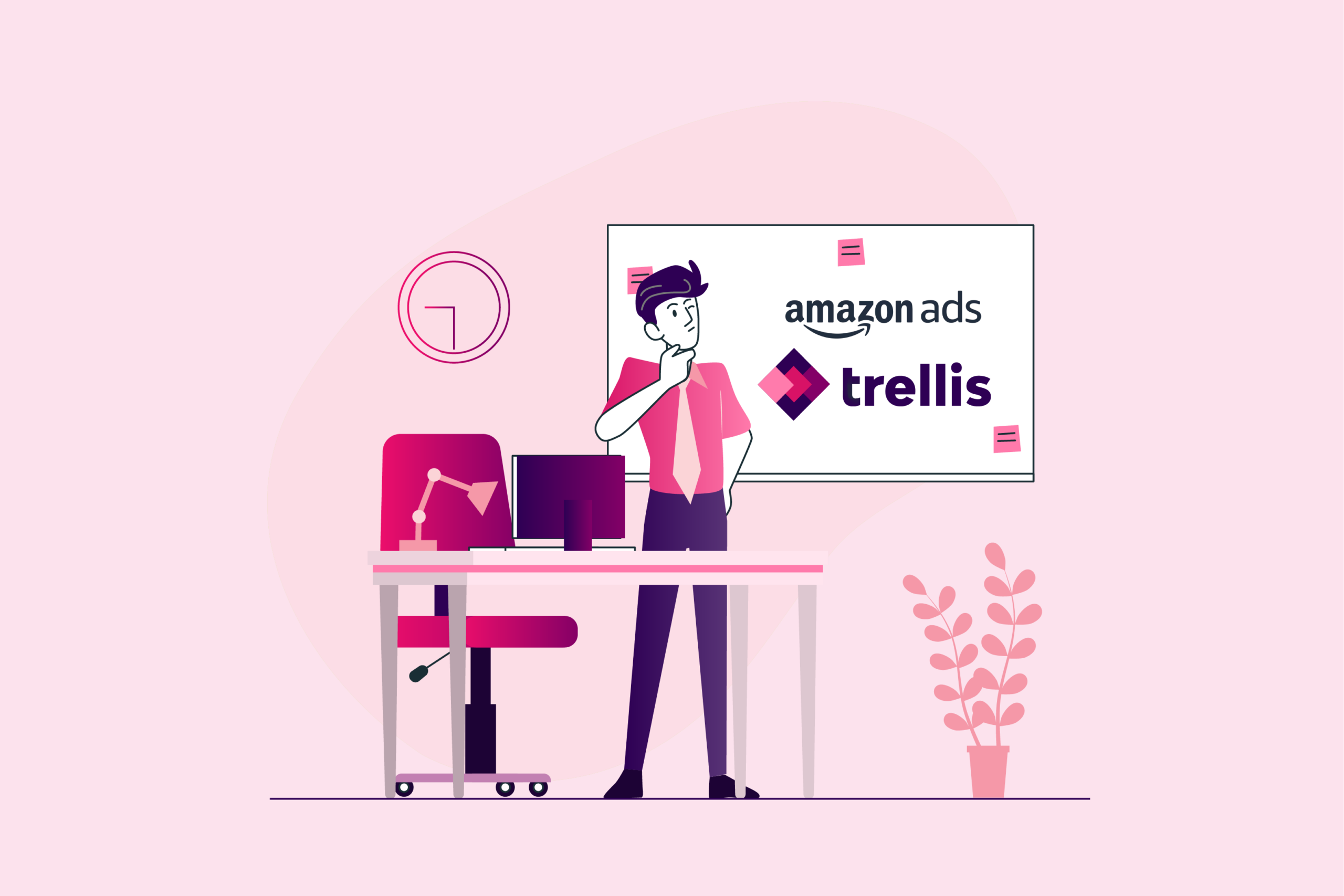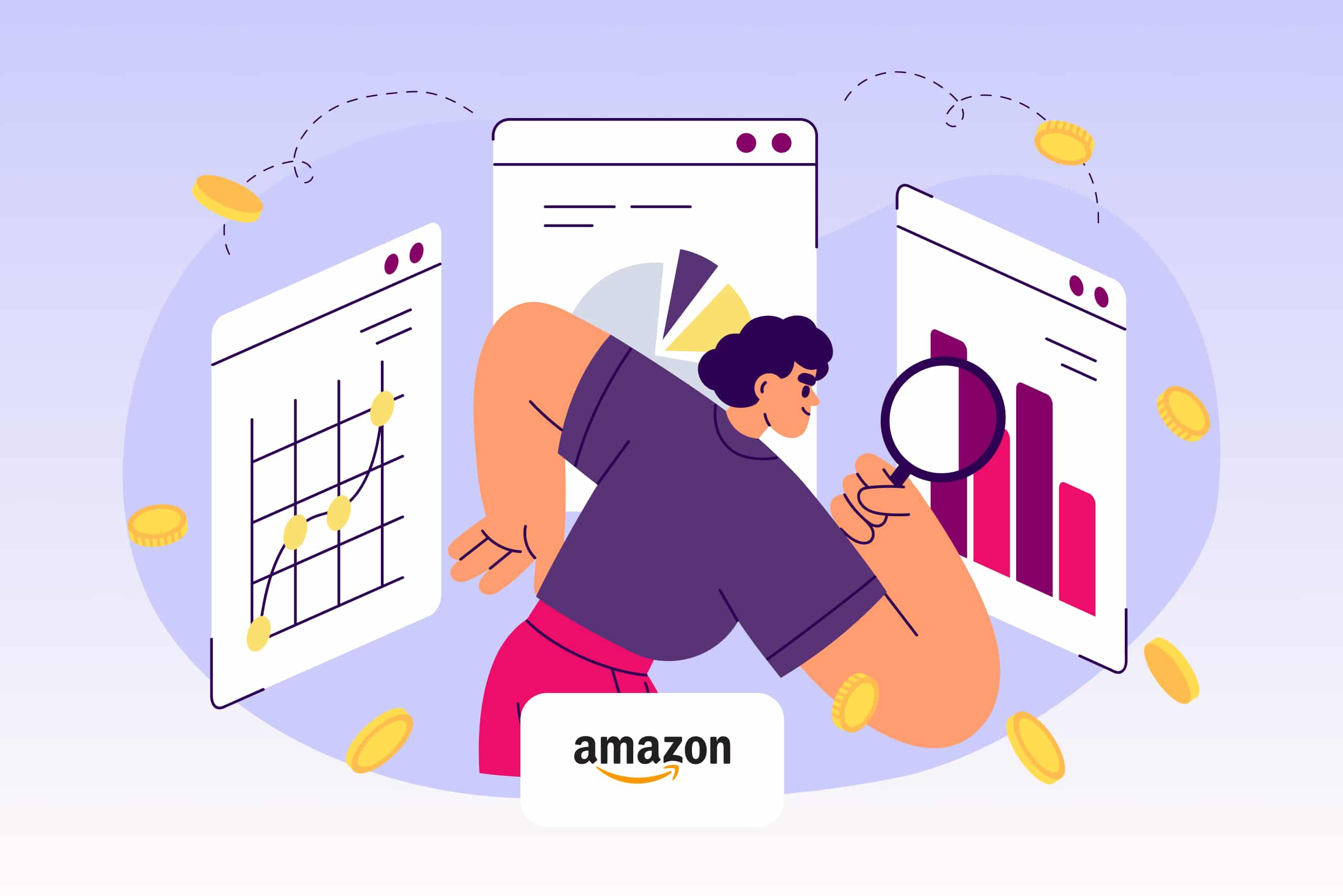Automation has been at the forefront of many industries and advertising is one of them. While technology impacts us in various ways, digital advertising can only benefit from it.
On marketplaces and advertising platforms like Amazon, automation gives a competitive advantage to sellers by saving them time and money.
Digital advertising is data-intensive and AI tools do an effective job of automating most tasks.
To address some of the weaknesses of automation, tools like ours, provide users with some controls. With our customers, we’ve found that this hybrid approach is best for advertisers who like to self-manage, lack resources and time, or have too many products to maintain.
Whereas, Manual Campaigns are strictly best for advertisers with expertise, a dedicated team, or a workflow that gives them the desired results.
In this blog, we will explore how you can save time and money and get results when preparing, creating, analyzing, and optimizing your campaigns.
Preparing stage
Before creating a new campaign on Amazon, you need to prepare a few things:
- A+ content: A well-optimized Amazon listing with SEO content can help with better convertibility and organic ranking.
- Keyword discovery: Broad, exact, phrase keywords that resonate the most with your product and brand.
- ASIN discovery: Competitor products that match your product for better targeting
- Competitor analysis: Insights on how to stand out against competitors.
Keyword/ASIN discovery
Trellis’ Advertising Automation does keyword/ASIN discovery using the content on your listings, historical performance, and competitor data. Our proprietary algorithm finds the best keywords and ASINs to target.
Whereas, with Manual campaigns, there is a lot of leg work costing you time and money, just to get you started. Moreover, for thorough keyword research, a paid tool may be required too.
Even Amazon Auto-campaign can help with keyword/ASIN discovery, but that would again require time and ad spend to gather data. Because auto campaigns cast a wider net, it can be expensive just to start your initial analysis.
Then, even if you get the right keywords and ASINs to target, there is a risk of missing out on some profitable keywords due to human bias, error, or oversight of similar keywords. For instance, if you are selling jackets, you may miss out on the term ‘coats’.
Competitive pricing
Being one of the 4Ps in marketing theory, pricing in digital marketing is critical. For example, some consumers are more price-sensitive when it comes to commodities because it is easier to compare prices online, and are more likely to buy the cheaper option with convenience.
A thorough competitive analysis can give you an edge in eCommerce and let you set the right pricing strategy. However, the prices change quite often for online products, and automating it can save time.
It also takes time and effort to properly test products and to model their elasticity, something you’ll only want to do occasionally. As such, you want a system that can do this work for you while providing you with statistically significant outcomes
Once this profiling is complete, Trellis’ Dynamic Pricing platform suggests the best pricing every day and auto-updates them daily, so you can get the most profitable pricing. Learn more here.
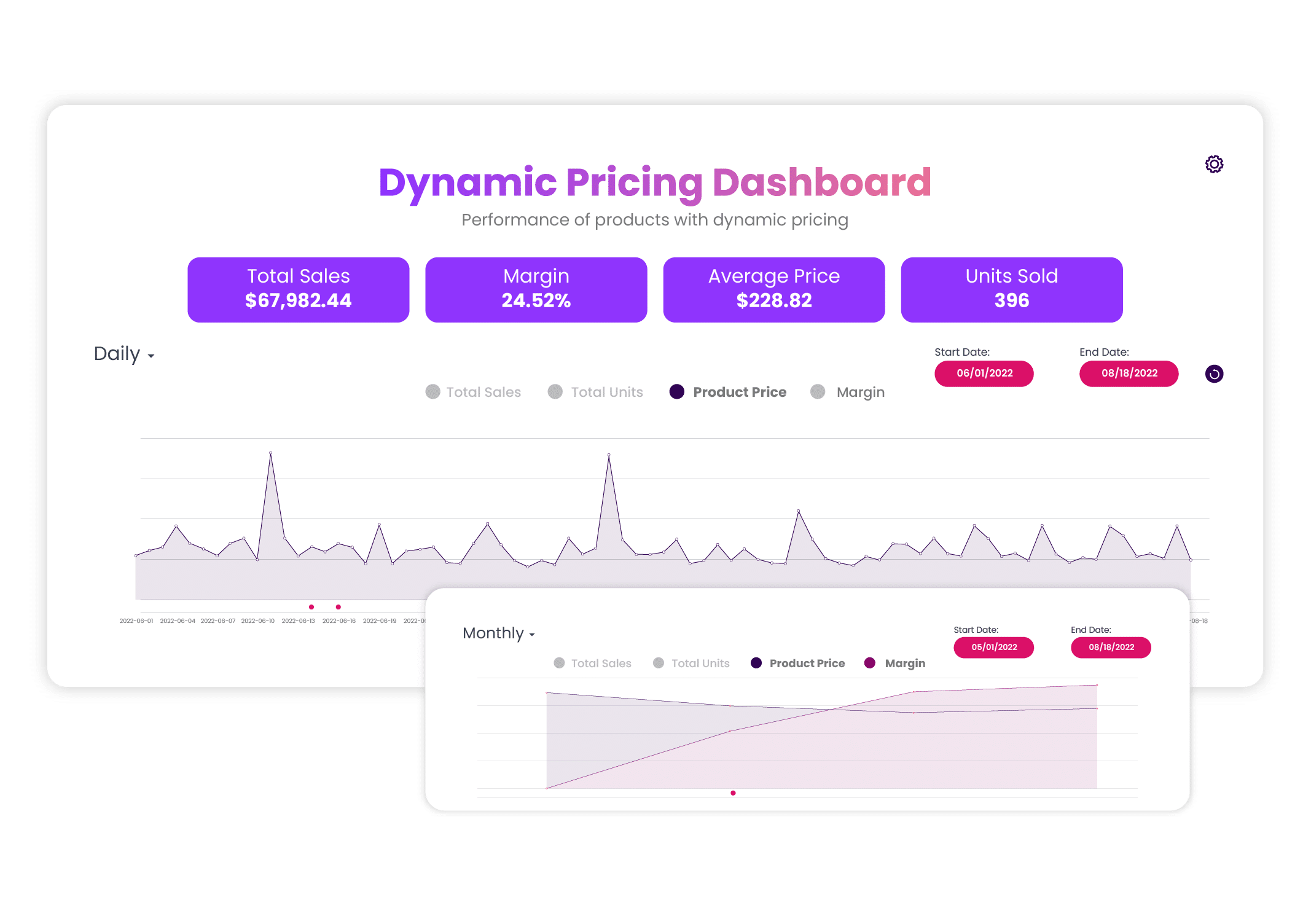
Built-in video maker
Several studies show that product videos convert more. However, it takes time and resources to create one. And if you have a range of products, it would cost even more.
Trellis offers a Built-in Video Maker which uses templates and makes creating a product video feel like a breeze. Improving your A+ content can go a long way to maximize conversions, clicks, and rankings, reflecting a lower TACoS (Total Advertising Cost of Sale).
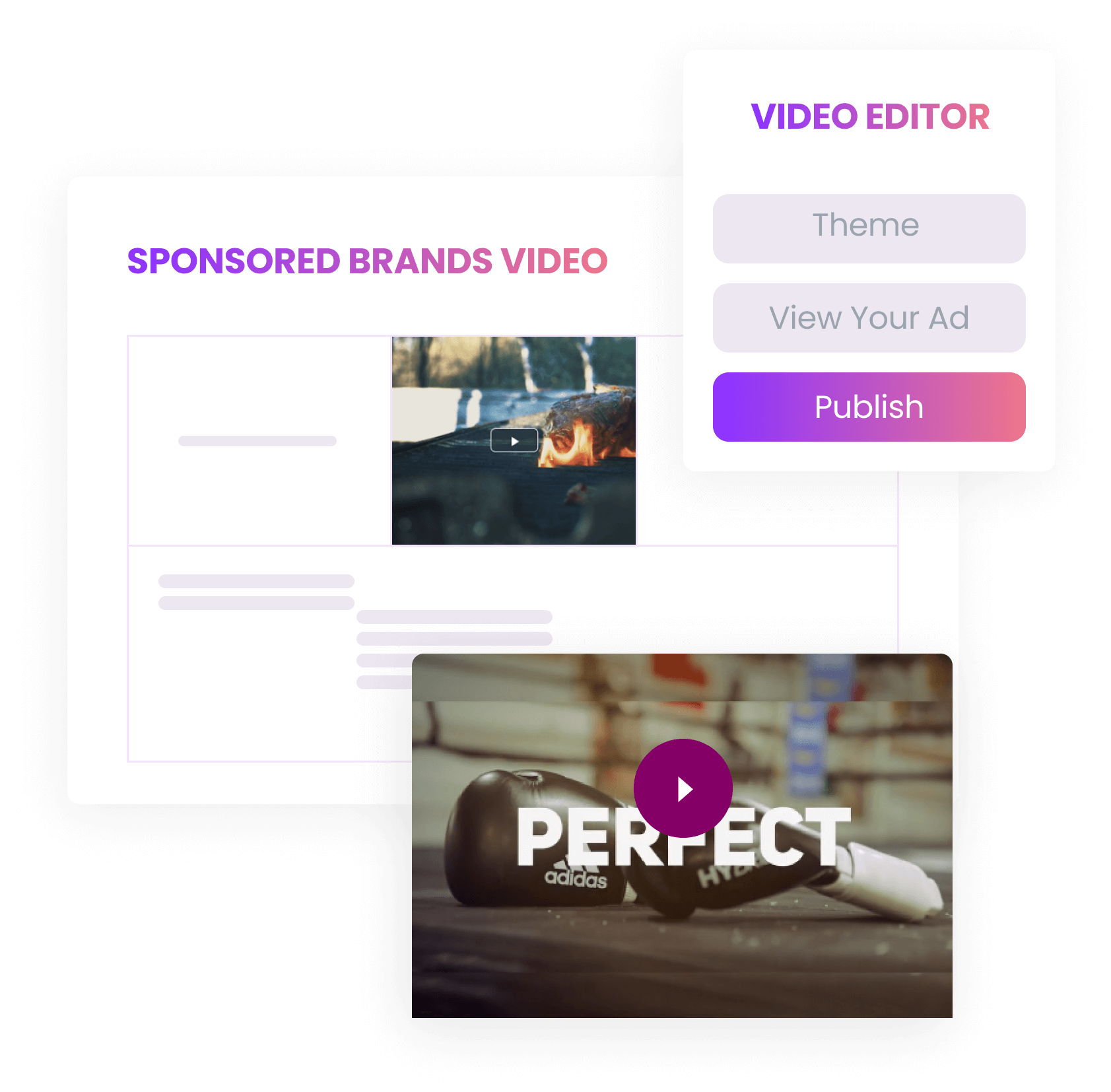
Save money
Doing manual keyword research can take too much time which can be saved through automation tools. Trellis can help your prepare for ad campaigns quickly by finding new keywords, identifying your pricing strategy, and creating a quick product video. Using tools can lower your starting costs and forecast a higher ROAS even before you get started.
Creating stage
To create an ad campaign, you need to consider the following:
- Goal: Whether you are launching a new product, or starting a new ad campaign on the existing one, both will have different goals and strategies.
- Budget Strategy: Determining how much money you want to allocate for single or multiple campaigns.
- Bidding Strategy: What’s the most you would want to pay for a given keyword or ASIN targeting?
- Keywords/ASIN Targeting: After doing the keyword research, decide what your best target keywords and ASINs.
Goal
While creating a Manual Campaign, you need to reverse engineer your objective to pick an ad strategy that meets your goal. This usually requires some level of advertising experience, and it could take a lot of time if you have little.
With Trellis’ Composite Media Plan, you can go custom, or pick a defined goal from the following:
- Demand Generation: Increase consumer awareness and demand for your products.
- Product Launch: Make an impact with successful new product launches.
- ACoS Optimizations: Drive profits to new heights with data-driven tools.
- Share-of-Voice: Thrive in competitive marketplaces by outranking competition with powerful, data-driven keywords.
The algorithm will optimize your ads according to the goal selected. Once you’ve picked a goal, you can select your Maximum ACoS, Target ACoS, and daily budget.
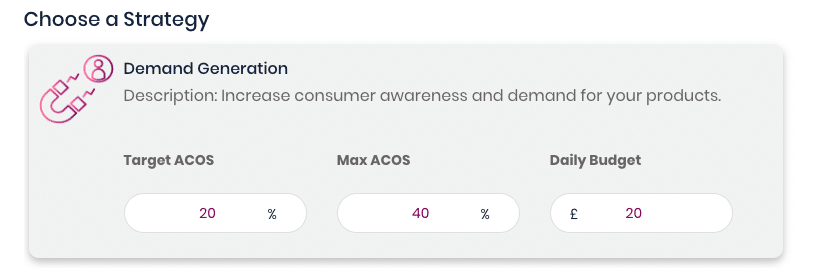
Strategy
With Trellis’ Composite Media Plan, your bidding and budgeting strategy becomes simple and unified to the goal and the ad type you select:
- Sponsored Product: Display individual product listings on Amazon product pages and related shopping results.
- Sponsored Brand: Promote your brand and products in a customized ad at the top of related Amazon product pages.
- Sponsored Brand Video: Engage customers with video ads that appear alongside related products.
- Sponsored Product Harvesting: Amazon will automatically calculate the best time and place to display your product ad. Recommended for PPC beginners.
- Sponsored Display: Reach customers with informative and attractive ads that appear on relevant Amazon pages.
Our algorithm runs data-driven bidding and budgeting strategies synced with both, the goal and the ad type. With daily automated bids and smart budgeting, you can get a competitive edge by saving on costs and testing your best keyword/ASIN.
Whereas in Amazon Campaigns, despite having more control, you would require time, money, and expertise to manage it just as well. After picking a budget and selecting the auto or manual campaign option, you pick a budget strategy for your ad group:
- Dynamic Down-only: If a click is less likely to convert, the bid is reduced by up to 100%
- Dynamic Up-down: If a click is likely to convert, the bid is increased up to 100%. Else, Down-only applies.
- Fixed default: Bids remain the same as the default.
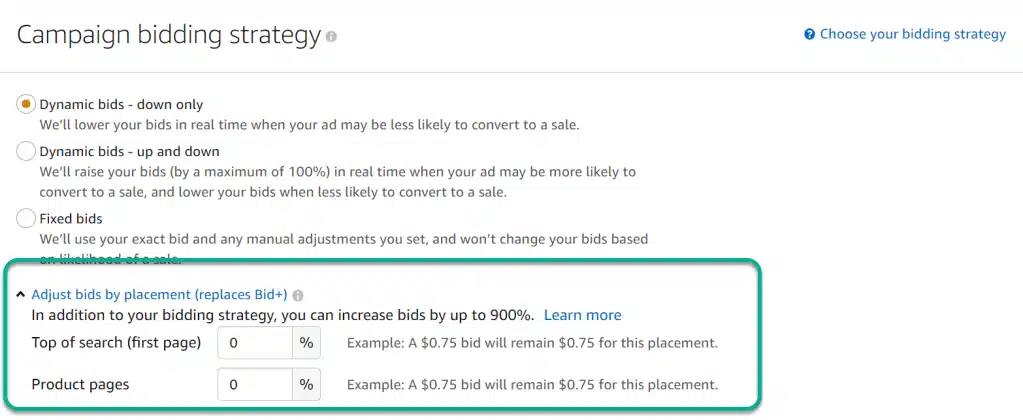
While this gives some dynamic control, budget allocation within the campaign is not possible with a native Amazon ad campaign. It is recommended to create a different ad group or campaign every time you want to test a new strategy because you can not allocate a budget within an ad group or campaign.
Therefore, Manual Campaigns can take more resources and time to manage each campaign if you want to test different strategies.
Funnel Targeting
Trellis Advertising uses full-funnel targeting, where it learns to identify keywords/ASINs that perform better at different buying stages based on historical performance.
As the campaign runs, it continues to promote or relegate products based on performance. This is helped by a retail semantic analyzer that sorts and groups keywords for funnel targeting.
For Manual Campaigns, sorting each keyword on performance may not be manageable. Therefore, most advertisers only run campaigns on a list of manageable target keywords.
Trellis algorithm is able to manage and analyze more data, which lets the self-managed advertiser have more time on their hands doing other tasks such as working with logistics or suppliers.

Save time
Creating a Manual Campaign is effective but slower as it requires several layers of optimizations.
With Trellis, you can create a campaign quickly through our Composite Media Plan, and align your goals and strategies. Our platform starts picking up keywords from your listing and optimizes as the campaign continues to run till the next stage.
Analyzing stage
Analyzing the output continuously and optimizing campaigns accordingly is the core expertise required from a PPC Manager.
Without the tools, you need to go fully manual, putting too much analytical, administrative, and research pressure on the team. However, automation and analytical tools make several repetitive tasks and decision-making easier.
Keyword harvesting
The second component of keyword research is Keyword Harvesting. After the initial discovery of keywords, you must continuously identify the best-performing keywords given your strategy, target ACoS, and budget.
Trellis’ proprietary algorithm runs daily to identify the best broad, phrase, and exact high-converting keywords and ASINs. However, there is less control for the advertiser and some may not be comfortable giving away their control.
Alternatively, for Manual Campaigns, you need to trust your team and their analysis which would cost way more. The best source of analysis for the Manual team is Amazon’s Search Term Reports (SRT) which can only be generated on a weekly basis.
Data analysis
In Manual Campaigns, to target effectively, the SRTs need to be put through complex spreadsheets and pivot tables to figure out budget allocation, and bidding strategies for each keyword or ASIN.
Data Analytics and keyword harvesting become more time and energy-consuming when there is a range of products or categories.
Trellis’ AI algorithms are designed to proceed with the most profitable bidding choices analyzed through algorithms — which is nearly impossible for human beings.
Therefore, automating keyword harvesting is more cost-effective than hiring an analytically skilled team.
Save resources
One of the most time-consuming and crucial things a PPC Manager does is data analytics and taking action on them. This is a time-consuming task that requires a lot of diligence which could make or break the performance of a campaign.
Optimizing stage
When it comes to optimization, Manual Campaign management offers control over bidding for each keyword, ad group, or campaign. Although with budget control there are limitations if campaigns and ad groups are not individually tested.
Control
With Trellis, you give away some control to our algorithms. While it does give you time to work on other tasks, some advertisers may not be comfortable spending money through an algorithm.
Our algorithms use advances in AI and ML such as probabilistic exploration and exploitation to fuel sales growth and optimize bids. Our algorithms are further trained to filter our seasonal, weekly, and daily sales trends to drive campaign performance.
After analyzing campaign performance, each bid has to be updated daily for every keyword or ASIN to maximize the competitive edge. Due to competition, it becomes difficult to keep running highly optimized bids, which is why automation makes things faster and more efficient in many ways.
Automated bids can save a lot of time as advertisers don’t need to monitor and change bids daily. Letting the algorithm set daily bids would not appeal to advertisers with few listings. However, many experts would take that option if they had hundreds of products.
Budget allocation is another control many advertisers would give up, as it would take too much time sorting percentages for each product. With Trellis Automation, smart budgeting enables allocating more to keywords/ASINs performing, and vice versa. Manual Campaigns are structurally cumbersome and don’t allow budget reallocation within a campaign.
Manual data cycles run in a waterfall, while with automation, data is auto-fed with continuous optimizations. While both optimizations take away control, they offer a speedy process.
Accelerate the process
With Trellis, analytics and optimizations converge into a faster cycle that tests, learns, and makes changes. While automation saves time, it also reacts quicker to bids and trends which lets you improve campaigns for the target ROAS.
And the winner is…
It depends, but eCommerce is becoming more about speed. The faster you test, analyze, and optimize, the better. Most advertisers cannot do that as fast as their competitors, or many do not know how. Automation lacks human intervention, which is good if you can learn to trust it.
If you want to learn more about the Trellis Advertising and Analytics platform, get in touch with us. We can provide a demo, where you can decide if our platform will help you grow.



